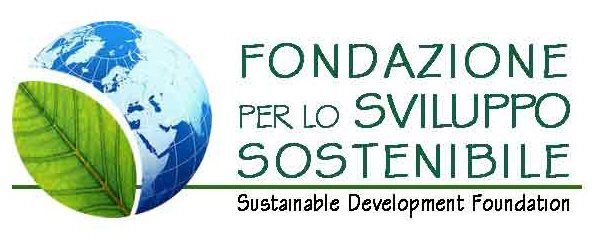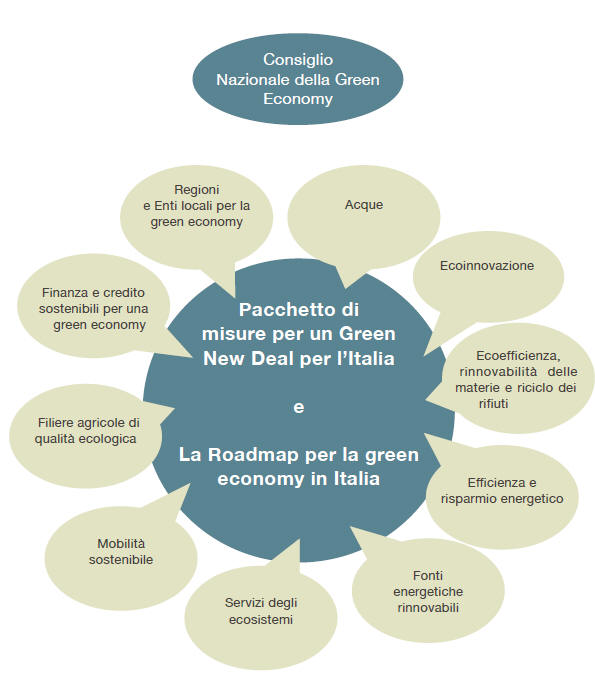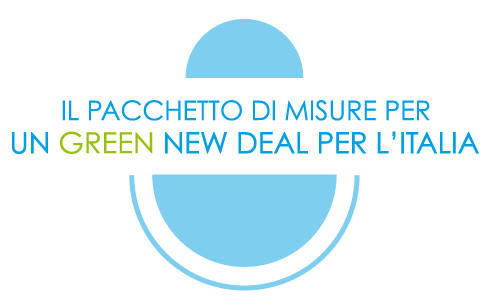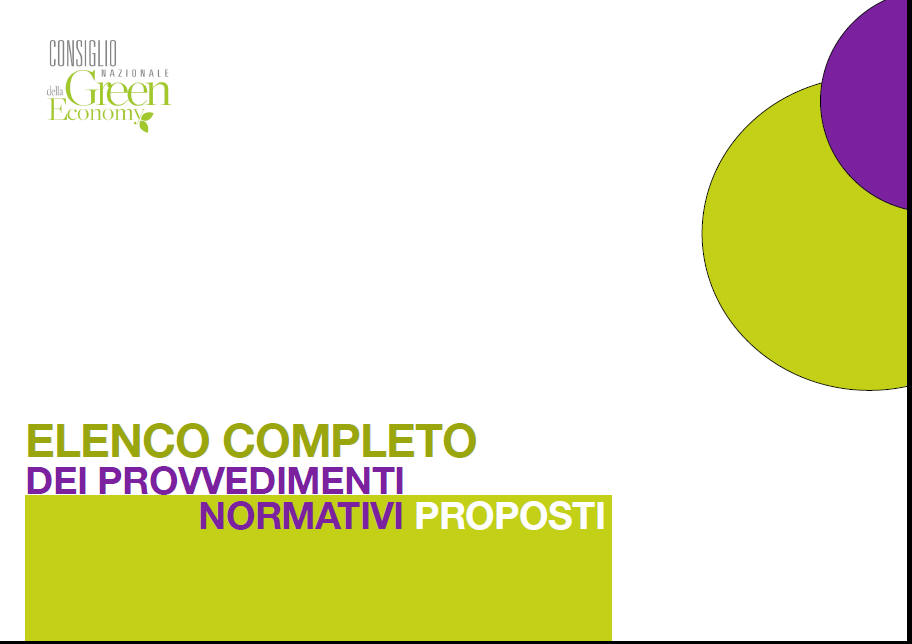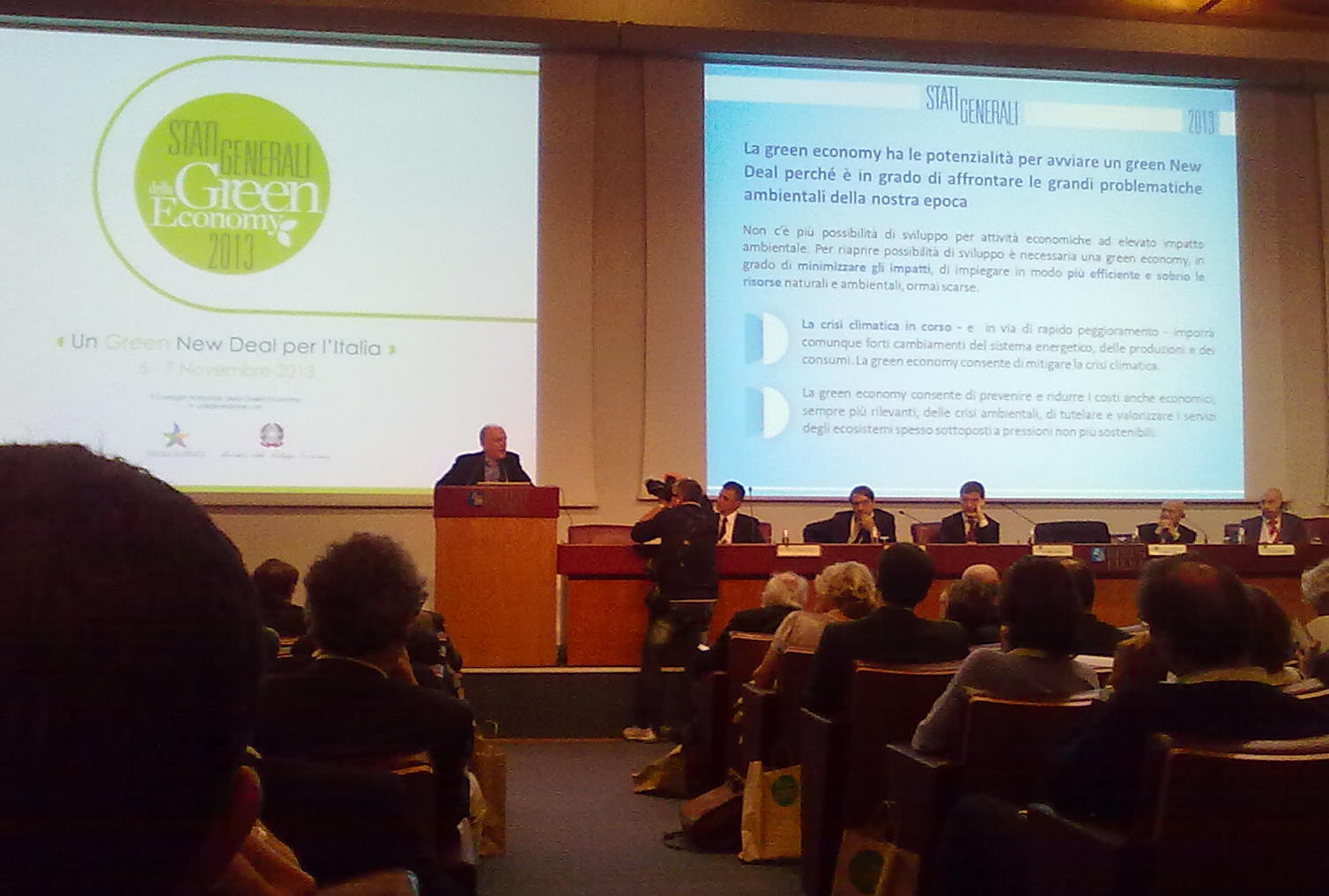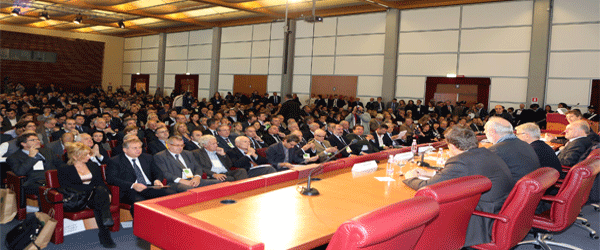|
Torna a: Homepage del Comitato scientifico Sviluppo sostenibile Green economy Clima Energia Trasporti Territorio Gli stati generali della Green economy con il patrocinio del Ministero dell'Ambiente Rimini, 6-7 novembre 2013
|
|||||
|
Home Green economy e green jobs assessment L'economia circolare Le iniziative nazionali Saggi e monografie L'Europa Le NGO Rio+20 |
|||||
|
I documenti strategici finali Dieci misure per un Green New Deal
Gli Stati generali della Green economy dimen-sionano quello che dovrà essere il percorso di un Green New Deal per l'Italia. I punti program-matici, già delineati dagli stati generali del 2012, trovano in questi dieci punti una precisa siste-mazione strategica ed attuativa (> leggi il documento dei dieci punti). La Roadmap per la Green economy in Italia
Il Documento program-matico in 77 punti con-clude gli Stati generali della Green economy del 2013. Traccia i linea-menti del Green New Deal per l'Italia. Se ne legga il testo completo o una breve sintesi nella colonna accanto. La lista completa delle misure proposte
Il documento raccoglie tutte le proposte e i provvedimenti elaborati nel corso dell'attività 2013 dei gruppi di lavoro (> scarica la matrice delle proposte). I Gruppi di lavoro del Consiglio Nazionale della Green Economy I Gruppi di lavoro, che coinvolgono in modo permanente circa 350 esperti in tutta Italia, preparano le bozze dei documenti per la con-sultazione sui temi dei 10 settori strategici, raccol-gono e valutano, con il supporto della Segreteria organizzativa, le osser-vazioni emerse nella consultazione e elabora-no i documenti intro-duttivi. I 10 settori strategici della green economy:
|
Il pacchetto delle dieci misure per un Green New Deal per l'Italia (> i dieci punti in italiano, > the "Ten measures in english) "Per affrontare la crisi italiana servono misure innovative che, senza aumentare né il debito pubblico, né la pressione fiscale, siano in grado di ridurre i costi, non solo ambientali ma anche economici, di produrre benessere, di attivare nuovo sviluppo durevole, una ripresa degli investimenti e dell'occupazione. Con un processo di elaborazione, articolato in dieci gruppi di lavoro e numerosi incontri di approfondimento, il Consiglio nazionale della green economy ha varato questo pacchetto di misure per lo sviluppo di una green economy in grado di attivare un vero e proprio green New Deal per l'Italia" 1. Attuare una riforma fiscale ecologica che sposti il carico fiscale, senza aumentarlo, a favore dello sviluppo degli investimenti e dell’occupazione green. 2. Attivare programmi per un migliore utilizzo delle risorse europee e per sviluppare strumenti finanziari innovativi per le attività della green economy. 3. Attivare investimenti che si ripagano con la riduzione dei costi economici, oltre che ambientali, per le infrastrutture verdi, la difesa del suolo e le acque. 4. Varare un programma nazionale di misure per l'efficienza e il risparmio energetico. 5. Attuare misure per sviluppare le attività di riciclo dei rifiuti. 6. Promuovere il rilancio degli investimenti per lo sviluppo delle fonti energetiche rinnovabili. 7. Attuare programmi di rigenerazione urbana, di recupero di edifici esistenti, di bonifica, limitando il consumo di suolo non urbanizzato. 8. Investire nella mobilita sostenibile urbana. 9. Valorizzare le potenzialità di crescita della nostra agricoltura di qualità. 10. Attivare un piano nazionale per I occupazione giovanile per una green economy.
FOR A GREEN NEW DEAL FOR ITALY
(Proposed by the
National Council of the green economy
1. Implementation of an ecological tax reform that shifts the tax burden, without increase, in favor of a green investment for development and employment Remove incentives for economic activities that have negative impacts on the environment, reconsidering the spending review, with more attention to the negative impacts to the environment, create measures of ecological taxation (a gradual carbon tax, road pricing, etc.), increasing the share of the regional fund financed on landfill tax and use the additional revenue obtained with these measures to achieve tax deductibility of investments that promote eco-innovation and to reduce the tax wedge on labour, especially in the green economy activities. 2. New programs to enable a better use of European resources and to develop innovative financial instruments for the green economy activities Starting a national program that aims to support a better use of EU funds greater use of the funds from the European Investment Bank and a growth of the Italian projects financed by Community funds (such as those made available by the programs ELENA and European Energy Efficiency Fund) for the green economy activities. Design and testing promote of innovative financial instruments such as project bonds, the performance bond, the social impact bond or other mechanisms based on the principles of "payment by results" or "Impact finance" or "crowd funding": with such innovative financial instruments related to the results, the aim is to reduce the cost of money, to promote public-private partnerships, stimulating an increase in quality as well as quantity, of green initiatives. Increasing green public procurement of goods and services to achieve the objectives of the National Action Plan for the sustainability of the purchases of public administration, strengthening the governance system, clarifying responsibilities and accountability, improving transparency, controls and providing appropriate tools to support. 3. Turn on investments that pay for themselves by lowering the economic costs as well as environmental, green infrastructure, soil conservation and water In addition to reducing emissions of greenhouse gases, we need to invest in mitigation and adaptation measures to reduce the risks and costs of the climate crisis by focusing on the development of green infrastructure: interventions based on natural solutions cheaper and longer lasting that in many cases create locally employment opportunities. The green infrastructure - consisting in city interventions such as parks development, gardens, trees but also green roofs and walls and, more generally, by natural areas and habitats networks - are useful not only to mitigate the climate crisis but can be designed and operated even to protect biodiversity and provide a wide range of ecosystem services. Soil protection is certainly one of the most significant public works and urgent needs of our country. We need a prevention planning for hydro geological and soil protection, a law that regulates safety of the area, methods of acquisition and tracking of data on the hydro geological phenomena, adequate and stable over time funding and measures to subtract investments for prevention constraints of the Stability Pact. It should improve the spending power of the actuators through coordination and simplification of procedures. Water is a common good ever more important to invest to ensure its protection and to avoid wastage is necessary to ensure the quality and quantity for drinking water and for environmental, agricultural and industrial use as well. Therefore is necessary to ensure proper planning and management, giving full operational to the river basin districts, ensuring resources available to qualifying for this purpose the use of the Structural Funds 2014-2020 and make the most eco-efficient public spending program to improve and protect the water quality, and to reduce waste and promote efficient use with system solutions characterized by high flexibility and have a reduced environmental impact, ensuring a high re-use of treated wastewater, combined with technologies that reduce the amount of water used to irrigate. It should also recognize the economic value of services provided by aquatic ecosystems, introducing recovery cost in environmental and resource concession fees of public water-coordinated hopefully – and in the rates of water service that should be provided with adequate measurement systems. It should enhance the water-saving rewards through actions such as the introduction of blue certificates - to be awarded to those who use water resources in a sustainable way - and incentives for reuse of treated wastewater, particularly in the agricultural sector. 4. Launch of a national programme of measures for energy efficiency The rise up to 65% of the tax deduction for improvements in energy efficiency should be made permanent. The implementation of the Energy Efficiency Directive 27/2012 is an opportunity to promote a Roadmap to 2030 with binding targets for energy efficiency, which also includes the regeneration of the building stock (which must be planned by the end of April 2014) to achieve the target to retrain annually 3% of government buildings. It should be promoted the retraining of buildings promoting financing plans, with guaranteed return from the energy savings obtained, backed by warranty and support mechanisms. The experience of the Covenant of Mayors and action plans for sustainable energy should be enhanced, promoting the implementation of interventions paying particular attention to offices, schools and public lighting, promoting the application of energy service contracts with guarantee results and, in addition, for such contracts should be confirmed a facilitated VAT of 10% for the private sector. For these types of investments is necessary to define a clear path to avoid incurs in the block resulting from the application of the Stability Pact. It should be quickly activated the guarantee fund provided for the construction of district heating networks to be entered in the ordinary programming of basic urban services. The promotion of investments in energy efficiency can be enhanced with the use of rigorous and ambitious technological standards (from household appliances to electric motors, from lighting to buildings). SMEs should be helped through the funding of energy audits aimed at identifying energy waste and by providing revolving funds or incentives as required by Directive 2012/27UE. It is necessary to revise the decree of April 5th 2013 in favor of energy-intensive companies, introducing - in the case of a reduction of the charges of the electrical system for energy-intensive companies - the obligation to adopt energy analysis and energy efficiency improvement programs. 5. Implement measures to develop waste recycling The current setting of waste taxation (TARES) must be modified avoiding to absorb the costs of waste management in a service tax, and restoring, where it was already done, and extending a “punctual” pricing for the management of municipal waste, adopting a mechanism that ensures to cover the costs and gives rewards to those who waste in a differentiated way, through the development of a pattern of rules to facilitate the adoption of these measures by local actors. Encourage and measure, in addition to waste collection, the actual recycling. Ensuring the real priority of recycling versus energy recovery and discourage the use of landfill. Ensure that the manufacturers of all types of goods contribute financially in an appropriate manner, for the collection and recycling of the waste they generate and involving them in the recycling of their products. Secure payments by public administration, develop research, improve regulations, provide a reliable framework, simplify procedures including those related to the end of waste, so as to encourage the recycling of waste. Also promote the integration of production processes and recycling of waste at the local level . Promote the use of materials and products from recycling activities, with appropriate and reliable technical specifications and with the improvement of Green Public Procurement. 6. Stimulate investment in the development of renewable energy sources Reduce production costs by simplifying and making more effective the system of rules and procedures, solving the problems introduced by the Ministerial Decrees of 2012 with the auction mechanisms and registers, providing a harmonization of the institutional attributions and authorization procedures and extending self-certification combined with effective control mechanisms and sanctions, also activating a online procedure integrated and time binding. In the context of a gradual overcoming of the incentives system, lightening the burden on bills and avoiding measures with retroactive effects that discourage investors, it’s necessary to set a target for the development of renewables by 2030 and act on different levels, such as:
7. Implement programs of urban regeneration, recovery of existing buildings, and reclamation, limiting the consumption of non-urbanized land The urgent relaunch of the construction industry and an efficient provision of housing, must be pursued by urban renewal programs and by the recovery, restoration, renovation, reuse and retrofit of existing buildings. The remediation of contaminated sites and brownfields - for which there is also the need for a more incisive action of information - can become an effective instrument for the protection of environmental resources (soil and groundwater) and for the recovery of all areas to a productive use and to attract investments, reducing the consumption of new soil. To facilitate these reclamations, simplifications, faster procedures and new modes of operation of the Service Conferences are needed, suitable in particular for the protection of groundwater, for the economic redevelopment of the sites and to update and coordinate risk analyses, calculations procedures and limit values. There is a need for effective measures to stop the abnormal consumption of non-urbanized land, to protect the agricultural production and the ecosystem services that it provides (hydro-geologic, biodiversity, etc.), as well as to promote recovery activities of existing buildings and the reuse of urbanized areas . It is furthermore necessary to enable participatory processes for the development of smart and sustainable cities, promoting voluntary agreements and innovative measures - involving institutions, universities and research centres, enterprises and citizens - for the green regeneration of our cities. 8. Investing in sustainable urban mobility Through the implementation of the Directive Eurovignette III, introduce a system of road pricing, differentiated according to the specific emissions of vehicles and congestion of the road and motorway networks. Establishing and maintaining a new "National Fund for Sustainable Mobility", with which to finance the development of new networks and initiatives, particularly for sustainable urban mobility, by means of the proceeds of the toll system, of a quote of the Transport Ministry funds for long - and medium - haul infrastructure financing, and with a shared revenue from the excise tax on fuel (increased by the progressive reduction of exemptions of transport modes, such as road transport and civil aviation). The Fund defines the areas for priority action, for the period 2014-2020, by a comparative evaluation of the reduction of impacts, and identifies the urban minimum standards:
9. Enhance the growth potential of our quality agriculture It is necessary to promote investments by farmers in activities of organic farming, quality and short- chain productions, even through the agri-food and rural districts, and to strengthen activities in the key green sectors that ensure the greatest chance of economic success for our agriculture. The purchase and consumption of quality food products, obtained with sustainable short-chain processes, must be encouraged through targeted actions aimed at strengthening the direct sales and the provision of unused public urban areas to facilitate food markets for farmers. Good results can also be obtained by the inclusion of short-chain organic food into the green public procurement of the public administration. Private initiatives, aimed at enhancing the multifunctional dimension of agriculture, should be encouraged through the taxation reduction. In particular, the development of agriculture and activities traditionally associated with agricultural production must me integrated with actions aimed at promoting multifunctional jobs as a means of organization, maintenance and use of the territory as a whole. 10. Activate a green economy national plan for youth employment We need to promote youth employment significantly reducing, for at least three years, the taxes and contributions for the employment of young people. It is necessary to establish a national plan for the development of youth employment, supported with training and qualification initiatives, with the aim of giving more strength to the Made in Italy manufacturing, coupled with the beauty and ecological quality, with clean production and products of high ecological quality through:
Il percorso del New Deal per l'Italia attraverso la transizione verso la Green economy (> la roadmap in settantasette punti) I. Misure generali per una green economy 1. Puntare sulla green economy come via per affrontare le crisi molteplici – economica, ecologica e occupazionale – che stanno affliggendo l’Italia 2. Diffondere la nuova visione della green economy 3. Migliorare e rafforzare la comunicazione agli investitori e ai mercati sui vantaggi della green economy 4. Valorizzare il potenziale green delle imprese italiane 5. Rafforzare un uso mirato degli strumenti economici 6. Adottare misure di fiscalità ecologica 7. Promuovere un migliore utilizzo delle risorse dei fondi europei 8. Migliorare e rafforzare, agendo sulla regolazione e sulla leva fiscale, le iniziative degli istituti di credito per la green economy 9. Fornire funding a basso costo agli istituti di credito 10. Promuovere e sostenere iniziative green oriented nell'ambito del venture capital e del private equity 11. Accrescere il contributo delle assicurazioni per il sostegno ad un'adeguata gestione del rischio ambientale. 12. Incentivare investimenti e impiego di risorse finanziarie, pubbliche e private in modo mirato, nella direzione dei cambiamenti 13. Accrescere la domanda sia pubblica (public procurement) che privata di beni e di servizi ad alto valore ambientale 14. Rendere obbligatoria la pubblicazione degli indicatori chiave di impatto ambientale come parte integrante dei bilanci aziendali 15. Creare un idoneo Fondo di garanzia nazionale 16. Supportare, anche attraverso il sostegno a progetti pilota, la progettazione e la sperimentazione di strumenti finanziari innovativi 17. Migliorare l’attenzione alla legalità 18. Definire un quadro normativo coerente, stabile, efficace 19. Valorizzare il ruolo delle Regioni e degli Enti locali II. Ecoinnovazione L’eco-innovazione, necessaria allo sviluppo di una green economy, promuove sistemi di produzione e consumo basati su un utilizzo sostenibile delle risorse e una riduzione degli impatti negativi sull’ambiente e cambiamenti culturali e di stili di vita. 20. Defiscalizzazione della spesa, direttamente riferibile a investimenti e occupazione 21. Individuare e adottare standard per la qualificazione dell’ecoinnovazione 22. Creazione di una funzione di Agenzia Nazionale per l’uso e la gestione efficiente dei materiali e delle risorse naturali 23. Sviluppare partenariati fra le Università, gli Enti di ricerca, le imprese e le amministrazioni locali 24. Sviluppare l’economia della conoscenza 25. Attivare processi partecipativi per lo sviluppo delle città intelligenti e sostenibili (Smart City) III. Ecoefficienza, riciclo e rinnovabilità dei materiali L’ecoefficienza nell’impiego dei materiali e nella prevenzione della produzione di rifiuti, lo sviluppo del riciclo e l’abbattimento dello smaltimento, la produzione e l’impiego di materiali rinnovabili locali, avranno un’importanza strategica crescente sia per assicurare la disponibilità di risorse, per ridurre la dipendenza dalle importazioni e l’esposizione ai loro costi crescenti nonché per ridurre gli impatti ambientali. 26. Ridurre la produzione di rifiuti intervenendo nella progettazione dei beni e degli imballaggi, nei processi produttivi e nei consumi 27. Sviluppare il riciclo dei rifiuti e abbattere lo smaltimento in discarica 28. Sviluppare il mercato delle materie prime seconde e dei prodotti realizzati con materiali riciclati 29. Sviluppare la standardizzazione dei materiali e dei prodotti derivati dal riciclo dei rifiuti 30. Incrementare la ricerca applicata, la diffusione delle innovazioni e delle migliori tecnologie di riciclo 31. Misurare le quantità di rifiuti effettivamente riciclate 32. Sostenere lo sviluppo della produzione e dell’utilizzo di materie prime biodegradabili
IV. Efficienza e risparmio energetico L’efficienza e il risparmio energetico presentano diversi e indiscutibili vantaggi sia ambientali (un minor consumo di energia, per la gran parte ancora di origine fossile consente di ridurre, per esempio, le emissioni di gas di serra), sia economici (riduzione dei costi energetici e delle importazioni di energia). 33. Standard di prestazioni energetiche inferiori del 30% di quelli attuali 34. Introdurre dal 2015 l’obbligo di realizzare edifici pubblici nearly zero energy 35. Confermare l’IVA al 10% 36. Favorire l’utilizzo del green public procurement 37. Promuovere la massima efficienza elettrica nell’illuminazione pubblica 38. Promuovere sistemi di gestione dell’energia e la formazione di energy manager e di esperti in gestione dell’energia 39. Recepire la Direttiva europea sull’efficienza energetica 40. Spostare gli incentivi per l’efficienza energetica sempre più verso il cliente finale 41. Agevolare l’efficienza energetica nella Pubblica Amministrazione V. Fonti energetiche rinnovabili Il settore energetico è responsabile di circa i due terzi delle emissioni mondiali di gas serra. A fronte di un obiettivo di riduzione delle emissioni mondiali pari al dimezzamento rispetto al 1990, negli ultimi venti anni sono cresciute di oltre il 40%. A fine settembre 2013 l’IPCC ... ha portato .... un rapporto mastodontico ... Rispetto al precedente la scienza climatica ha fatto molti progressi e i risultati sono in una ancora più chiara evidenza del mutamento in atto: “il riscaldamento climatico è inequivocabile e molti dei cambiamenti osservati a partire dagli anni ’50 non hanno precedenti per decine di millenni addietro … le concentrazioni in atmosfera di CO2, metano e protossido di azoto sono cresciute a livelli mai visti almeno negli ultimi 800 mila anni … la concentrazione di CO2 è aumentata del 40% rispetto al periodo pre-industriale, … l’influenza umana sul sistema climatico è evidente … contenere il cambiamento climatico richiederà riduzioni sostanziali e durature delle emissioni di gas serra” ... La lotta al cambiamento climatico, i cui effetti potenzialmente catastrofici sono evidenti già oggi, rappresenta probabilmente la principale sfida della nostra epoca e le fonti rinnovabili sono uno degli strumenti principali per affrontare e vincere tale sfida nonché per ridurre la dipendenza dalle importazioni energetiche.
42. Definire un quadro strategico nazionale di medio termine per il settore energetico e gli strumenti più idonei alla sua attuazione 43. Semplificare le procedure e ridurre i costi burocratici per la realizzazione di impianti per le rinnovabili 44. Sostenere gli investimenti per arrivare a un progressivo superamento del sistema degli incentivi 45. Rafforzare ed estendere il Fondo per la ricerca e coinvolgere anche le imprese 46. Varare un programma nazionale di adeguamento delle reti energetiche 47. Prevedere misure a favore della generazione distribuita 48. Definire una roadmap a medio-lungo termine per lo sviluppo delle tecnologie per le fonti rinnovabili 49. Promuovere un’azione specifica per il sostegno allo sviluppo delle rinnovabili termiche 50. Predisporre una strategia nazionale per il rilancio della filiera delle biomasse 51. Ridefinire il ruolo del settore termoelettrico da fonti tradizionali in un sistema a forte penetrazione di rinnovabili VI. Tutela e valorizzazione dei servizi degli ecosistemi La Roadmap europea per lo sviluppo della Green Economy dedica grande attenzione al ruolo del capitale naturale e dei servizi ecosistemici. Vi si afferma che nuova economia deve puntare su un’elevata qualità ecologica e sulla ricostituzione e valorizzazione del capitale naturale, che costituisce la base indispensabile per il benessere e per un durevole sviluppo economico. L’attuale contesto di crisi economica, che impone riforme strutturali e un radicale cambiamento di visione, spinge a sua volta ad approfondire questi orientamenti. Per questo anche nel nostro Paese le nuove strategie economiche devono tener conto di fattori e interventi, fino ad oggi scarsamente considerati, legati sostanzialmente alla valorizzazione dei servizi forniti dagli ecosistemi. 52. I servizi degli ecosistemi 53. Biodiversità e “infrastrutture verdi” 54. Tutela e valorizzazione del territorio 55. Contenimento del consumo di suolo non urbanizzato 56. Prevenzione del dissesto idrogeologico e sviluppo dell’occupazione giovanile 57. Promozione di un Piano nazionale di tutela e gestione della Risorsa Idrica 58. Riqualificazione delle città 59. Tutela e valorizzazione delle aree naturali protette 60. Sviluppo delle bonifiche e recupero dei siti contaminati VII. Filiere agricole di qualità ecologica Le filiere agricole, da quella prioritaria delle produzioni alimentari, fino a quelle delle agroenergie, delle produzioni di materiali biodegradabili, dell’agriturismo e della gestione forestale e del territorio, possono avere importanti prospettive di sviluppo puntando sull’elevata qualità ecologica.61. Preservare la destinazione d’uso ed arrestare il consumo del suolo agricolo62. Promuovere la multifunzionalità e la pluriattività nelle aree agricole63. Favorire l’occupazione giovanile in filiere agricole di qualità ecologica64. Rafforzare l’informazione dei consumatori65. Promuovere lo sviluppo delle agroenergie66. Incentivare l’uso efficiente della risorsa idrica in agricoltura67. Presentate proposte di emendamento (Vedi Allegato 1) 68. Promuovere il ruolo dell’agricoltura nei territori montani e collinari e nelle aree protette, nonché nelle aree urbane69. Incrementare la sostenibilità ambientale e sociale della filiera agroalimentare70. Identificare una condivisa strategia di salvaguardia dei paesaggi agrari tradizionaliVIII. Mobilità sostenibile 71. Ridurre la crescita tentacolare delle città attraverso la rigenerazione urbana 72. Dare priorità alla mobilità urbana sostenibile 73. Espandere la diffusione di veicoli a basse emissioni, attraverso pedaggi differenziati e altre forme di incentivazione 74. Sviluppare infrastrutture digitali al servizio dei trasporti.75. Raddoppiare al 2030 la quota modale del trasporto merci su ferrovia e dei treni passeggeri regionali e metropolitani76. Far decollare il telelavoro77. Realizzare un trasporto marittimo a bassi consumi energetici e valorizzare la “transizione verde” dei porti italiani
|
||||
|
|||||
